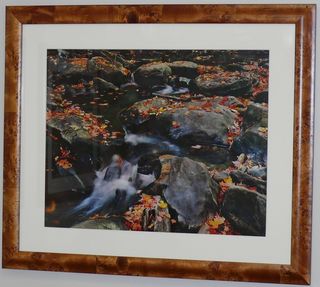 Art has been shown to have a calming and healing effect, which makes it a vital presence in a hospital environment. This is especially true in an intensive care unit which can be a frightening experience for both patients and visitors, with all its unfamiliar equipment and sounds.
Art has been shown to have a calming and healing effect, which makes it a vital presence in a hospital environment. This is especially true in an intensive care unit which can be a frightening experience for both patients and visitors, with all its unfamiliar equipment and sounds.
When the neurosurgical intensive care unit at the Hospital of the University of Pennsylvania was being planned, the cost of the advanced technology necessary to provide life-saving care to its patients –- many of whom have suffered severe brain injury -- depleted the funding normally reserved for decorative art.The staff tried to be creative, framing neuro education posters and putting them around the unit, but that did not do the trick. So they sent a proposal to the Board of Women Visitors for a grant to use art to bring “comfort, solace and a welcoming atmostphere to our patients, families, and staff.”
Created in 1875, the Board of Women Visitors supports Penn Medicine in many ways but improving patient care and comfort remains their priority. Each year on average, the BWV approves $300,000 to help fund projects on the ‘wish lists’ of departments throughout the health system. Over the past couple years, approved proposals have included funding to provide furnishings for a postpartum family waiting room and for an ambulation program for elderly patients. Starting in 2007, the Board has also contributed $500,000 towards the creation of the Clyde F Barker Transplant House, which provides affordable, convenient and comfortable accommodations for transplant patients and their families.
The BWV generously provided a $20,000 grant to help transform the Neuro ICU. Staff members met with art specialist Joan Swenson and chose pieces of art for the unit’s public areas, including around the nurses station, the waiting area, and, especially, the consultation room, which seemed cold and uninviting. “That’s where we’re telling families critical information about their loved one, where they sometimes have to make life or death decisions,” said Mary Ledwith, the unit’s nurse manager.
After much debate, the unit’s Healing Arts Committee chose 25 pieces, in a variety of subject matter and mixed media . Some are traditional paintings of nature, while others are more modern, such as the colorful glass discs that now grace the walls of the consultation room. Not surprisingly, feedback from both patients and staff has been positive.
Even Florence Nightingale knew the impact of art on patients. In her book Notes on Nursing, she writes about art, “People say the effect is only on the mind. It is no such thing. The effect is on the body too.”